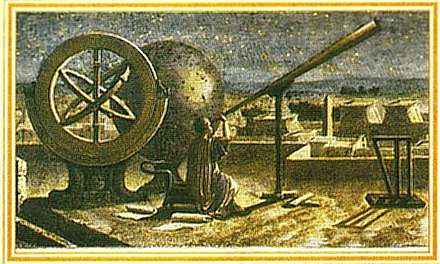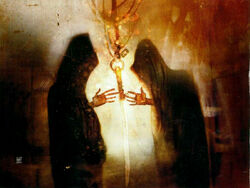
"Anaxagoras, Democritus, and their schools say that the milky way is the light of certain stars." -- Aristotle, philosopher,
Meteorology, Book I, 350 B.C.
"Of the Galaxy or the Milky Way: It is a cloudy circle, which continually appears in the air, and by reason of the whiteness of its colors is called the galaxy, or the milky way. Some of the Pythagoreans say that, when Phaeton set the world on fire, a star falling from its own place in its circular passage through the region caused an inflammation. ... Democritus [said], that it is the splendor which ariseth from the coalition of many small bodies, which, being firmly united amongst themselves, do mutually enlighten one another." -- Plutarch, historian,
On the Opinions of the Philosophers, Book III, 1st century
"He [Democritus] said that the ordered worlds are boundless and differ in size, and that in some there is neither sun nor moon, but that in others, both are greater than with us, and yet with others more in number. And that the intervals between the ordered worlds are unequal, here more and there less, and that some increase, others flourish and others decay, and here they come into being and there they are eclipsed. But that they are destroyed by colliding with one another. And that some ordered worlds are bare of animals and plants and all water." -- Hippolytus, priest,
The Refutation of All Heresies, 2nd century
"He [Democritus] was a pupil of some of the Magi and Chaldaeans, whom Xerxes had left with his father as teachers, when he had been hospitably received by him, as Herodotus [Metrodorus] informs us; and from these men he, while still a boy, learned the principles of astronomy and theology." -- Diogenes Laertius, historian,
Life of Democritus, 3rd century
"... sight is made precise by the compass, rule, and telescope." -- Iamblichus, philosopher,
Life of Pythagoras, 3rd century
"It is reported that Democritus the Abderite was wise, besides other things, in desiring to live unknown, and that he wholly endeavoured it. In pursuit whereof he travelled to many Countries; he went to the Chaldæans, and to Babylon, and to the Magi, and to the Indian Sophists. When the estate of his Father Damasippus was to be divided into three parts amongst the three Brothers, he took onely so much as might serve for his travel, and left the rest to his Brethren. For this Theophrastus commends him, that by travelling he had gained better things than Menelaus and Ulysses." -- Aelian, historian,
Various History, Book IV, Chapter XX, 3rd century
"Greater things than these may be performed by refracted vision. For it is easy to see by the canons above mentioned that the greatest objects may appear exceedingly small, and the contrary, also that the most remote objects may appear just at hand, and the converse; for we can give such figures to transparent bodies, and dispose them in such order with respect to the eye and the objects, that the rays shall be refracted and bent towards any place we please, so that we shall see the object near at hand or at any distance under any angle we please. And thus from an incredible distance we may read the smallest letters, and may number the smallest particles of dust and sand, by reason of the greatness of the angle under which we see them. ... Thus also the sun, moon, and stars may be made to descend hither in appearance, and to be visible over the heads of our enemies, and many things of the like sort, which persons unacquainted with such things would refuse to believe." -- Roger Bacon, natural philosopher,
Opus Majus, 1267
"[Roger Bacon] did perfectly understand all kinds of optic glasses, and knew likewise the method of combining them so as to compose some such instrument as our telescope." -- William Molyneux, natural philosopher,
Dioptrica Nova, 1692
"If this steel mirror [the Pharos of Alexandria] did really exist we cannot refuse to the ancients the glory of the first invention [of the telescope], for this mirror can be only effected by as much as the light reflected by its surface was collected by another concave mirror placed at its focus, and in this consists the essence of the telescope and the merit of its construction." -- Georges-Louis Leclerc, Comte de Buffon, historian,
Natural History, 1749–88
"Some modern writers deny the fact that a great mirror was placed in the light-house of the Alexandrian port for the purpose of discovering vessels at a distance at sea. But the renowned [French historian] Buffon believed in it; for he honestly confesses that 'If the mirror really existed, as I firmly believe it did, to the ancients belong the honor of the invention of the telescope.'" -- Helena P. Blavatsky, theosophist,
Isis Unveiled, 1877
"The credit of the discovery of the telescope has been a fruitful subject of discussion. Thus, because Democritus announced that the Milky Way is composed of vast multitudes of stars, it has been maintained that he could only have been led to form such an opinion from actual examination of the heavens with a telescope. Other passages from the Greek and Latin authors have similarly been cited to prove that the telescope was known to the ancients." --
Encyclopaedia Britannica 1888, 1893, & 1911
"The Chaldeans must have understood the manufacture of the telescope, for [Austen H.] Layard reported the discovery of a lens of power in the ruins of Babylon. Nero the emperor of Rome had optical glasses from the east." -- Drusilla D. Houston, historian,
Wonderful Ethiopians of the Ancient Cushite Empire, Chapter XIII: The Civilization of Babylonia, 1926
"Thomas Wright marveled in 1750 that Democritus had believed the Milky Way to be composed mainly of unresolved stars: 'long before astronomy reaped any benefit from the improved sciences of optics; [he] saw, as we may say, through the eye of reason, full as far into infinity as the most able astronomers in more advantageous times have done since.'" -- Carl Sagan, professor,
Cosmos, 1980
"Galileo always insisted that the ancients had telescopes." -- Ivan Van Sertima, historian,
Blacks In Science: Ancient and Modern, The Lost Sciences of Africa: An Overview, 1983
"It is a short and simple step to place one lens in front of another to make a telescope, and the chances are it could have happened and many times." -- Hunter H. Adams III, archaeoastronomer, African Observers of the Universe: The Sirius Question, 1983
"The ancients apparently used the telescope long before Pythagoras's time." -- Larry B. Radka, historian,
Telescopes and the Ancients, 2010
George Rawlinson:
The Seven Great Monarchies of the Eastern World, Volume 4: Babylon, 1862-67
There is said to be distinct evidence that they [Babylonians] observed the four satellites of Jupiter, and strong reason to believe that they were acquainted likewise with the seven satellites of Saturn.
... strange as it may seem to us ... the Babylonians possessed optical instruments of the nature of telescopes, since it is impossible, even in the clear and vapor-less sky of Chaldaea, to discern the faint moons of that distant planet [Saturn] without lenses. A lens, it must be remembered, with a fair magnifying power, has been discovered amongst the Mesopotamian ruins.
Last year I got into a big argument with
Paul Cartledge and one of his stooges
James Warren over the issue of Democritus's unbelievably precise cosmology. Professor i.e. Sophist Paul Cartledge wrote to me in a personal email, "D's views- all his views - were purely theoretical and in no way empirically based or tested." To which I gave an Abderite LOL. According to them, Democritus was unable to observe because he lived before 1608 and therefore the greatest lucky guesser who ever walked the face of the Earth. Absurd and absolutely ridiculous. And they fancy themselves scholars. Pity.
















































